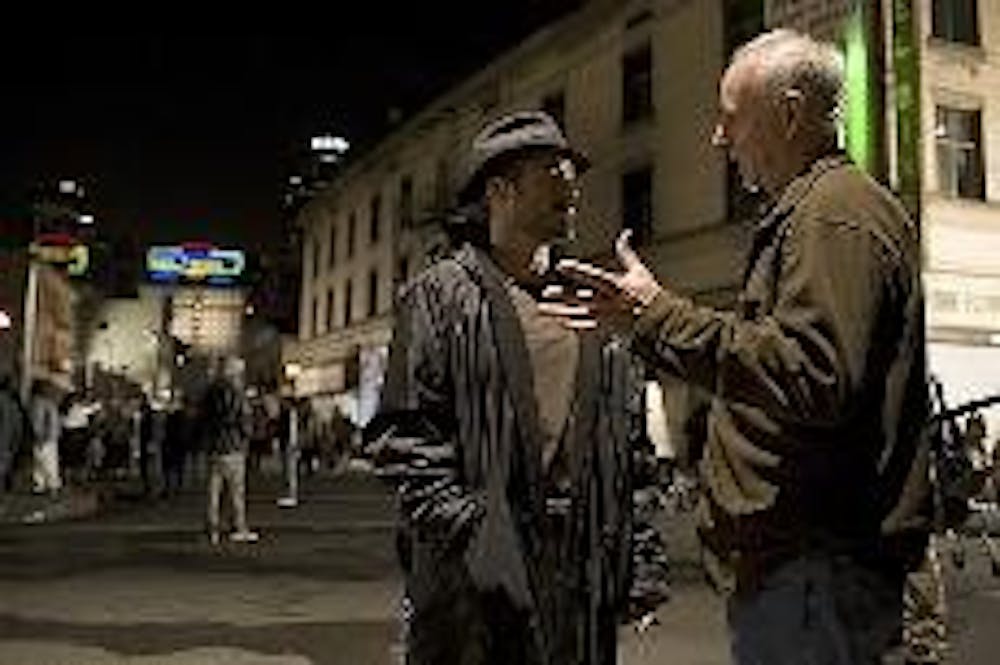The Soloist: C-
For a movie that profiles the crashes and falls of Beethoven's greatest symphonies and attempts to capture the heartbeat of Los Angeles itself, "The Soloist" feels remarkably claustrophobic. Despite immersive and touching performances by its stars, Robert Downey Jr. and Jamie Foxx, the film never reaches a viable climax and lacks any significant character or theme development.
"The Soloist," loosely based on a series of columns by L.A. Times columnist Steve Lopez (Downey), follows his experiences with the schizophrenic and homeless Julliard dropout Nathanial Anthony Ayers (Jamie Foxx).
In search of inspiration for his latest column, Lopez finds Ayers playing a two-stringed violin beneath a statue of Beethoven. The plot doesn't evolve much from the initial encounters between the two other than noting mild changes the characters undergo along their journey to correct their states in life. The film undergoes great effort to avoid the clichés that usually accompany those in its genre, frequently labeled "Oscar-bait."
Ultimately, it would have been more effective if it had at least momentarily embraced the sappy heart-to-heart relationship between Lopez and Ayers and left the worrying of "been there, done that" to more dynamic scripts.
While British director Joe Wright effectively captured the English countryside in "Pride and Prejudice" and the catastrophic remains of World War II battle sites in "Atonement," his translation to the gritty streets of L.A. is lacking. Much of the film's spirit lies in capturing the energy and plight of the homeless in the city. Yet even though Wright made the decision to cast many men and women plucked directly from local shelters, the immediacy and emotion of their ordeals doesn't come through.
The perspective of the film is limited in the flaws of its two main characters. Though Downey and Foxx utterly transform themselves into Lopez and Ayers, it's easy to quickly succumb to frustration at the inability of the two to go through many significant changes throughout the course of the movie.
In a phone interview with The Eagle, Lopez explained what he saw as the theme of the film.
"The story is about human connection," he said. "I think that everybody's goal in life is to connect with someone or something, and the fact that it can happen so serendipitously as this happened is really a special part of the story."
Perhaps the events in "The Soloist" were damaged by these very temptations of chance and spontaneity. Lopez's celluloid-based doppelganger seems almost too immersed in his own difficulties and faults to properly communicate with Ayers and evolve the plot. It's only in the last 10 minutes of the film that he seems to be able to bring himself to a state of polite friendship with Ayers, rather than the previous condition of neglectful condescension.
It's important to note that the troubled on-screen interpretation of Lopez is quite removed from his real-life inspiration, both in personality and marital status.
"I think that any artistic contribution is more viable if it's an original piece of work rather than a copy of something," Lopez said when asked about this difference. "I also think that if Downey played me specifically, it wouldn't be a very exciting character."
The movie could have benefited from Lopez's real-life compassion and eloquence, since Downey's character is given little room to evolve into anything more than the cold and harried newspaperman seen in so many films prior. Inhibited by the mental illness and the limited capacity to verbally communicate, Foxx is not left with many devices to warm the emotion of the film with.
It is significant that the climax of the movie can ultimately be categorized as Lopez forgiving Ayers for his anger and physical threat of violence. It's unfortunate that the film couldn't have come to the same terms of agreement an hour earlier, as to save us the rambling that gives off the air of a concerto that continues on well past its point of interest.
You can reach this staff writer at jcoughenour@theeagleonline.com.





